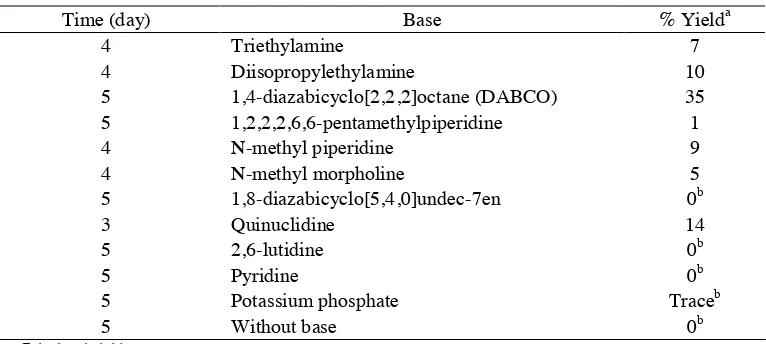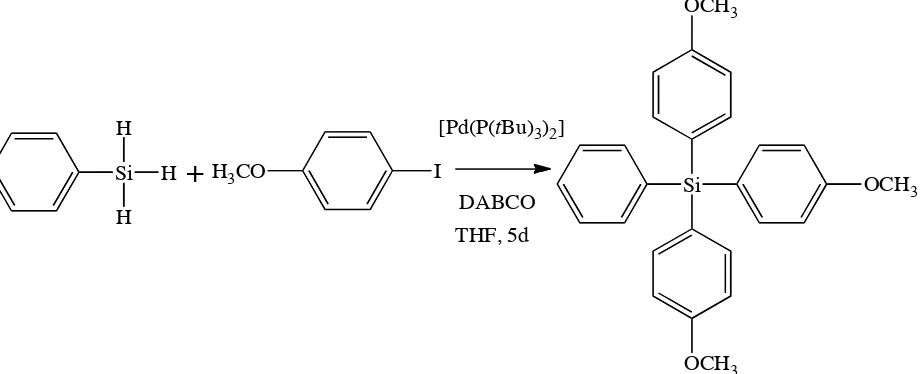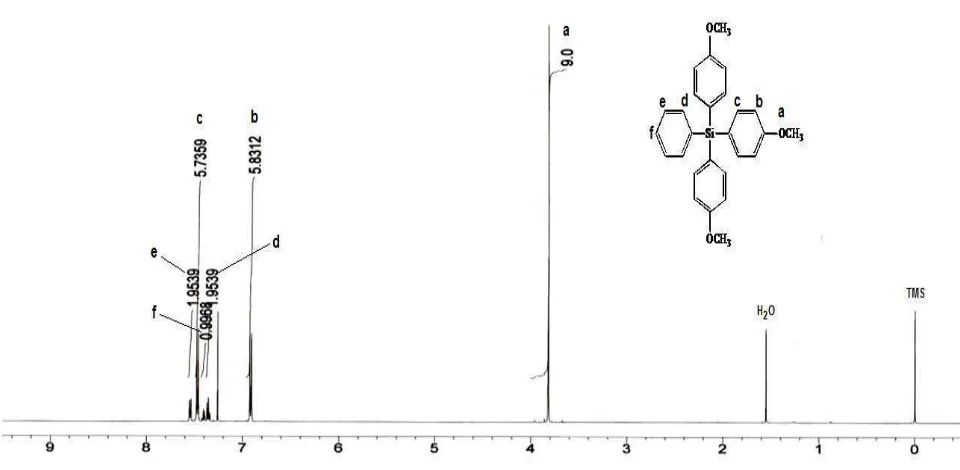Synthesis of Tris(4-Methoxyphenyl)Phenylsilane Using Phenylsilane and 4-Iodo
Anisole Catalyzed by Palladium Complex
Aldes Lesbani
1*, Risfidian Mohadi
1, Eliza
1, and Mardiyanto
21. Department of Chemistry, Faculty of Mathematics and Natural Sciences, Universitas Sriwijaya, Ogan Ilir 30662, Sumatera Selatan, Indonesia
2. Department of Pharmacy, Faculty of Mathematics and Natural Sciences, Universitas Sriwijaya, Ogan Ilir 30662, Sumatera Selatan, Indonesia
*
E-mail: [email protected]
Abstract
The synthesis of tris(4-methoxyphenyl)phenylsilan through the coupling reaction of phenylsilane and 4-iodoanisole using palladium tertiary tributylphosphine as a catalyst was carried out through the determination of the base, solvent, and reaction time. The results showed that tris(4-methoxyphenyl)phenylsilane can be synthesized to form maximum yield using 1,4-diazabicyclo[2,2,2]octane (DABCO) as a base, tetrahydrofuran as a solvent, and a 5-day reaction time. The highest yield of tris(4-methoxyphenyl)phenylsilane was 35%.
Abstrak
Sintesis Tris(4-Metoksifenil)Fenilsilan Menggunakan Fenilsilan dan 4-Iodida Anisol dengan Katalis Senyawa Kompleks Paladium. Sintesis tris(4-metoksifenil)fenilsilan melalui reaksi kopling antara fenilsilan dan 4-iodida anisol menggunakan senyawa paladium tersier tributilfosfin sebagai katalis telah dilakukan berdasarkan penentuan senyawa basa, pelarut, dan waktu reaksi kopling. Hasil penelitian menunjukkan bahwa senyawa tris(4-metoksifenil)fenilsilan dapat disintesis menghasilkan persentase produk maksimum pada penggunaan senyawa 1,4-diazabisiko[2,2,2]oktan (DABCO) sebagai basa, tetrahidrofuran sebagai pelarut, dan waktu reaksi kopling selama 5 hari. Persentase tertinggi produk senyawa tris(4-metoksifenil)fenilsilan adalah 35%.
Keywords: 4-iodoanisole, palladium, phenylsilane, tris(4-methoxyphenyl)phenylsilane
1.
Introduction
The coupling reaction is one of the most useful techniques for synthesizing valuable chemical materials [1]. This reaction has been developed in couplings such as Suzuki-Miyaura, Negishi, Heck, and Sonogashira. Prof Suzuki and Prof. Negishi won the Nobel Prize in 2010 for research of palladium as catalyst for coupling reaction in organic synthesis [2]. The coupling reaction occurs when a carbon-carbon chain is combined using a powerful catalyst such as a complex of transition metals [3]. The example this reaction is asymmetric synthesis of drugs with chirality in the compound [4], which is still developed until now.
The development of the coupling reaction has included various substrates depending on molecule targets. Previous research using trial oxysilane and aryl halide
enlarged the scope of coupling reactions by using not only aryl iodides [12–13] but also organosilicas [14–15] as starting materials. These researchers found that, although the various aryl iodides and organosilica can be reacted using palladium catalyst through the coupling reaction, there was a slight increase in the yield. Therefore, the optimization of the coupling reaction in this case is vital to increase the coupling product yield.
This present research examined the optimization of reactions of phenylsilane and 4-iodoanisole to tris(4-methoxyphenyl) phenylsilane by evaluating bases, solvents, and reaction times. The tris(4-methoxyphenyl) phenylsilane was synthesized using 1,4-diazabicyclo[2, 2,2]octane (DABCO) as a base and tetrahydrofuran as a solvent, and a 5-day reaction time.
2.
Methods
Materials and equipment. All experiments were carried out using Schlenk techniques under an argon or nitrogen atmosphere in a vacuum system. Chemicals 4-iodoanisole, palladium tertiary tributylphosphine, diethyl ether, tetrahydrofuran, dimethoxyethane, 1,4-dioxane, tetrahyd-ropyran, triethylamine, diisopropylethylamine, potassium phosphate, TLC plate, ethyl acetate, and dichloromethane were obtained from Merck. 1,2,2,6,6-Pentamethylpipe-ridine, N-methylpipe1,2,2,6,6-Pentamethylpipe-ridine, N-methylmorpholine, 1,8-diazabicyclo[5,4,0]undec-7en, quinuclidine, 2,6-lutidine, cyclopentyl methyl ether, and pyridine were obtained from Aldrich, and 1,4-diazabicyclo-[2,2,2]octane (DABCO) was obtained from TCI. All chemical were used immediately following purchase without further treatments. NMR spectra were recorded on JEOL 500 MHz for 1H, and 125 MHz for 13C in CDCl3. GC-MS
was performed on Shimadzu GCMS QP 2100. The sample was diluted in acetone before analysis.
Synthesis and characterization of tris(4-Methoxy phenyl)phenylsilane. Synthesis of tris(4-methoxyphenyl) phenylsilane was carried out at room temperature according to the literature [12] as follows: The solid reactants (i.e., palladium tertiary tributylphosphine 0.05 mmol) and base (i.e., potassium phosphate 5 mmol and 4-iodoanisole 3.5 mmol) were poured into a 100-ml isolated using column chromatography on silica and ethyl acetate as eluent. Pure product was characterized using GC-MS, 1H, and 13C NMR spectroscopies.
3.
Results and Discussion
The coupling reaction between 4-iodoanisole with phenylsilane, presented in Fig. 1, was carried out at room temperature. The effect of temperature was not studied due to the volatility of the starting materials. According to Fig. 1, the formation of tris(4-methoxyphenyl)phenylsilane depends on the base, solvent, and reaction time. In the first trial of this research, the effect of several bases in the reaction of 4-iodoanisole with phenylsilane were studied. The results of the influence of base are shown in Table 1.
Base is important for the reaction in Fig. 1 due to substitution of aryl iodide to the organosilica moiety. Theoretical calculations revealed that at least a 3-mol or mmol base is needed to remove three hydrogens in the reaction. Thus, aryl iodide reacts with organosilica to form the product. Table 1 shows that there is no product
Table 1. Optimization of Base
Time (day) Base % Yielda
4 Triethylamine 7
4 Diisopropylethylamine 10
5 1,4-diazabicyclo[2,2,2]octane (DABCO) 35
5 1,2,2,2,6,6-pentamethylpiperidine 1
5 Potassium phosphate Traceb
5 Without base 0b
a. % isolated yield
in the absence of base (entry 12). These results indicated that the base is crucial in the coupling of aryl iodide with organosilica. Inorganic bases, such as potassium phosphate (entry 11), gave trace amounts of tris(4-methoxyphenyl)phenylsilane. Various organic bases that are available commercially were tested in this reaction (entries 1–10) and resulted in several product percentages. Aliphatic amines, such as triethylamine and diisopropylamine, generated product in the range of 7–10% (entries 1, 2). This percentage is still low for the catalytic reaction process, although this reaction type is difficult. Thus,,by using cyclic, aromatic, and bicyclo in this research (entries 3–10), the scope of organic bases was enlarged. All cyclic, aromatic, and bicyclo used in this research contained nitrogen in their structures to react with hydrogen from silane in organosilica. Cyclic and aromatic bases, such as piperidine, quinuclidine, lutidine, and pyridine, generated coupling product of less than 14%. By using a bicyclo base compound, such as 1,4-diazabicyclo[2,2,2]octane (DABCO), the yield was slightly increased to 35%. DABCO was used as a base for the next optimization for the reaction. The reaction in entry 8 (quinuclidine) was stopped after 3 days, although the yield showed a slight increase. The formation of the product on the first and second days was similar and kinetically slow [16].
The characterization of the product was carried out using 1H, 13C NMR, and GC-MS [17]. After the isolation process, the pure compound of tris(4-methoxyphenyl) phenylsilane was dissolved in chloroform (d-1). The 1H NMR spectrum of tris(4-methoxyphenyl)phenylsilane is shown in Fig. 2. The 1H NMR spectrum indicated 6 equivalent protons in the product at chemical shifts 3.82 ppm (s, 9H); 6.92 ppm (d, 6H, J = 8.6 Hz); 7.35 ppm (q, 2H, J = 7.3 Hz); 7.40 ppm (m, 1H); 7.47 ppm (d, 6H, J = 8.6 Hz); and 7.53 ppm (q, 2H, J = 6.4 Hz). Six equivalent protons in the product were distributed as
methoxy, aromatic methoxy substituent, and aromatic of organosilane. The results are consistent with the structure of the product shown in Fig. 1. The 13C NMR spectrum of the product is shown in Fig. 3. All the carbon in tris(4-methoxyphenyl)phenylsilane had 9 equivalents at chemical shifts 55.0 ppm (CH3); 113.6
ppm (CH); 125.6 ppm (Cq); 127.7 ppm (CH); 129.3 ppm (CH); 135.4 ppm (Cq); 136.2 ppm (CH); 137.8 ppm (CH); and 160.7 ppm (Cq). Theoretical structural prediction reveals that the structure of tris(4-methoxyphenyl)phenylsilane, as shown in Figure 1, has 9 carbon equivalents. Thus, the results of 13C NMR are in accordance with the theoretical prediction.
The characterization using the GC-MS-produced spectrum is shown in Fig. 4. The molecular ion peak of tris(4-methoxyphenyl)phenylsilane was at m/z 426. The calculation of molecular mass was 426, atomic mass number 12 for carbon, 1 for hydrogen, 16 for oxygen, and 28 for silica. The characterization data showed that compound tris(4-methoxyphenyl)phenylsilane is purely synthesized by coupling 4-iodoanisole with phenyl silane using palladium tertiary tributylphosphine as the catalyst.
Various solvents (especially nonaqueous) are widely available for organic synthesis [18]. These solvents are generally water-free, because the universal properties of water can destroy the phenylsilane functional group before it reacts with 4-iodoanisole [19]. However, oxygen atoms bound in the solvent (such as in the ether group) have special solvent properties. This study investigated several solvents in the ether group. Cyclic and aliphatic ether were used as separate solvents in the reaction between 4-iodoanisole and phenylsilane. Table 2 shows the percentage of coupling product obtained using DABCO as base in an ether-based solvent.
Si
Figure 2. 1H NMR Spectrum of Tris(4-methoxyphenyl)phenylsilane
Figure 3. 13C NMR Spectrum of Tris(4-methoxyphenyl)phenylsilane
Aliphatic ether (entries 2, 5), such as dimethoxyethane and diethyl ether, did not strongly affect the product yield. Cyclic ether, such as tetrahydrofuran, 1,4-dioxane, tetrahydropyran, and cyclopentyl methyl ether (entries 1,3,4, 6), affected the formation a small amount. Similar results were generated (shown in Table 1) when DABCO was used as the base. The effect of reaction time on the formation of tris(4-methoxyphenyl)phenylsilane from 4-iodoanisole and phenyl silane is shown in Table 3 using DABCO as a base and tetrahydrofuran as a solvent. The reaction time was prolonged to 11 days using dimethoxyethane, 1,4-dioxane, and tetrahydropyran
as solvents, since the product formation remained very low after 5–6 days.
Figure 4. Mass Spectrum of Tris(4-methoxyphenyl)phenylsilane
5 Cyclopentyl methyl ether 20
a. % isolated yield
The coupling reaction between phenylsilane and 4-iodoanisole using palladium tertiary tributylphosphine yielded tris(4-methoxyphenyl)phenylsilane at 35% by optimization of the base, solvent, and reaction time. The maximum yield was obtained using DABCO as the base, THF as the solvent, and a 5-day reaction time.
Acknowledgements
Practical Guide, vol. 219, Springer-Verlag, Germany, 2002, p.248.[2] Y. Nishihara (Ed.), Applied Cross Coupling Reactions, vol. 80, Springer-Verlag, Germany, 2013, p.245.
[3] J. Tsuji (Ed.), Palladium Reagents and Catalyst, Wiley, Chichester, 2004, p.228.
[4] J.O. Daiss, C. Burschka, J.S. Mills, J.G. Montana, G.A. Showell, I. Fleming, C. Gaudon, D. Ivanona, H. Gronemeyer, R. Tacke, Organometallics 24
[10] A. Lesbani, H. Kondo, Y. Yamanoi, H. Nishihara, Jurnal Kimia 6 (2012) 1.
[11] A. Lesbani, H. Kondo, J. Ichi-Sato, Y. Yamanoi, N. Nishihara, Chem. Commun. 46 (2010) 7784. [12] A. Lesbani, H. Kondo, Y. Yabusaki, M. Nakai, Y.
Yamanoi, N. Nishihara, Chem. Eur. J. 16 (2010) 13519.
[13] A. Lesbani. R. Mohadi, Chem. Progress 5/5 (2012) 66.
[14] A. Lesbani, R. Mohadi, N. Hidayati, Elfita, Jurnal Molekul. 8 (2013) 58.
[16] G.E. Rodgers, Descriptive Inorganic, Coordination and Solid-State Chemistry, 2nd ed., Brook/Cole, USA, 2002, p.97.
[17] T.W.G. Solomons, C.B. Fryhle, Organic Chemistry, 9th ed., John Wiley & Sons, USA, 2008, p.363.
[18] P. Atkins, T. Overton, J. Rourke, M. Weller, F. Armstrong, Inorganic Chemistry, 4th ed., Oxford University Press, UK, 2006, p.135.



